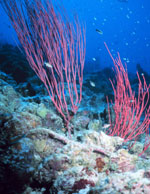One ocean binds together our world. Of that vast expanse of water, less than one-fourth of 1 percent is occupied by coral reefs — yet reefs are home to more than a quarter of all known marine fish species. Anyone who dives knows that these reefs are dying, but few understand the extent to which human activities threaten these undersea rainforests.

The living dead?
Photo: NOAA.
Four years ago, to help gauge the situation, my colleagues produced the first-ever detailed, map-based assessment of threats to coral reefs around the world. The map revealed a grim truth: 58 percent of the world’s reefs are potentially threatened. Many reefs lie just off the shores of regions of extreme poverty and rapid population growth, where human activities are often especially damaging to marine areas that were pristine just a few years ago.
The most species-rich and most extensive coral reefs in the world lie off the coast of Southeast Asia. The region is the global epicenter of marine diversity, containing nearly 34 percent of the world’s reefs and more than 600 of the 800 reef-building coral species. Sadly, these reefs are also the most threatened.
How threatened? A recent, detailed study, Reefs at Risk in Southeast Asia, used sophisticated computer software and a new index of threats to estimate that 88 percent of Southeast Asia’s reefs are severely imperiled by human activities. The main threats are from overfishing, destructive fishing, and sedimentation and pollution from land-based sources.
To get a sense of the scope of the threat, consider this: More than 90 percent of the coral reefs in Cambodia, China, the Philippines, Singapore, the Spratly Islands, Taiwan, and Vietnam are in danger. More than 85 percent of the reefs of Malaysia and Indonesia are threatened. Indonesia and the Philippines — among the world’s largest archipelagos — hold 77 percent of the region’s coral reefs and nearly 80 percent of all the threatened reefs.
Reef It and Weep
While the picture is grim, and Southeast Asia’s coral reefs will continue to deteriorate, there is a positive side to the assessment. Better information is now available to help natural resource managers, government officials, and ordinary fishers better manage coral reefs. At present, although there are 646 marine protected areas in Southeast Asia, only 14 percent of the 332 whose management status could be determined can be rated as effectively managed.

Looking for reef relief.
Photo: NOAA.
Careful management is critical, because it takes only days to destroy ancient coral reefs. Once destroyed, it takes a long, long time to rebuild the reefs. (Research by noted Filipino marine biologist Angel Alcala and the villagers of Apo Island in southern Philippines indicates that it takes from two to four decades after a marine area receives protection for it to reach its original carrying capacity.)
Sitting at a desk in front of a screen, these numbers — four decades, 14 percent, 600 species — may seem virtually meaningless. But for Southeast Asians and the conservation community, they are extremely important. Coral reefs are the cornerstone of the region’s economic and social fabric — the main source of food and livelihood for millions of fishers. And of course, the reefs are more that that. They are among the most beautiful, colorful, and intricate manifestations of the web of life, and they are essential to the overall viability of marine ecosystems.
Check out stats on the world’s coral reefs.

